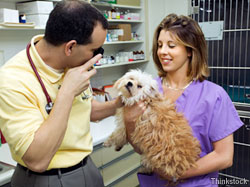(ARA) – Ask pet owners about their dogs and watch their eyes light up because of the bond they share. After all, Discovery News reports in an August 2009 article that dogs have been man’s best friend for some 10,000 years.
The American Veterinary Medical Association’s 2007 U.S. Pet Ownership and Demographics Sourcebook states that nearly 40 percent of all U.S. households include at least one dog and 32.8 percent own two cats. This amounts to 153 million four-legged friends in the nation. That’s a lot of patients receiving care from the veterinary community.
A professional alternative
If you have ever thought of working with animals as a career, you can follow a well-defined professional path. “Individuals interested in the veterinary profession may want to enroll in a two-year veterinary technician associate degree program, which prepares candidates to test for professional credentialing to enter the field. All states require a credentialing exam following completion of a veterinary technician program. Depending on individual state regulations, candidates may become registered, licensed or certified.
“Veterinary technicians work as support staff, similar to nurses working with doctors,” says Dr. Joshua Peterson, doctor of veterinary medicine (DVM), and veterinary technology department chair at Brown Mackie College – Kansas City. “There are only three tasks delegated specifically to veterinarians: diagnosing diseases, prescribing medications and performing surgery. “Technicians monitor patients and follow protocol procedures to administer vet-prescribed anesthesia during surgery. Vet techs also take X-rays, draw lab samples and run tests. X-ray and test results are then interpreted by the veterinarian.”
Greg Harvey, Registered Veterinary Technician (RVT), is a lead instructor of veterinary technology at Brown Mackie College – Kansas City, with 17 years of veterinary technician experience, and a colleague of Dr. Peterson. “A technician’s main goal is to do things that free the vet to do diagnostics, exams and surgery. A good tech can record a thorough patient history, take vitals and give the vet appropriate background on the patient,” Harvey says.
Do you have what it takes to become a vet tech?
“Many come into the program because of a strong love of animals,” says Harvey. “But it’s important to remember that a dog is an extension of a human being, and their owners do the talking. Candidates must have excellent people skills.” Peterson summarizes the traits necessary to become a vet technician. “We like to see strong scientific-minded people with good critical thinking and reasoning skills.” Core science classes in the vet tech program include biology, chemistry and mathematics.
“Candidates must also multi-task well,” Peterson continues. “No day is completely laid out. Emergency cases come in, and it’s not always pleasant. A certain amount of squeamishness in the beginning is normal. I can’t tell you how many times I’ve seen people faint in surgery. It’s something that needs to be overcome.”
Harvey adds good observation skills to the list of traits. “Animals can’t tell us where it hurts. Students have an opportunity to develop an understanding of how different animals exhibit pain. Cats will often stop grooming, and dogs can become withdrawn or more aggressive,” he says. “Confidence is also an important trait. Lack of confidence makes those around you nervous.”
Both Harvey and Peterson agree that veterinary technician is not a position for people who love daily routines. “You never know what will be thrown at you,” says Harvey.
A good opportunity for career satisfaction
“Being a veterinary technician is the most gratifying career I could have. I’ve worked with vets who have encountered new things after 20 or 30 years in practice,” Harvey says.
“I’ve always derived gratification from being an advocate for those who can’t speak for themselves,” Peterson says. “There is satisfaction in treating an animal that is hurt and scared, and restoring it to health. I get to see how happy it makes their owners as well.”
Courtesy of ARAcontent

